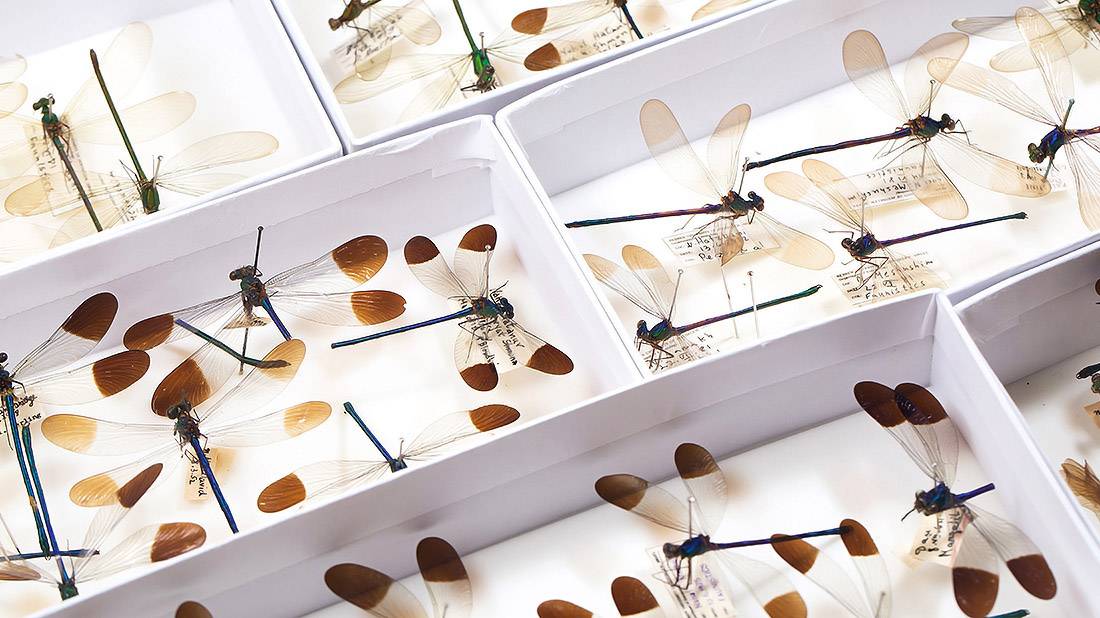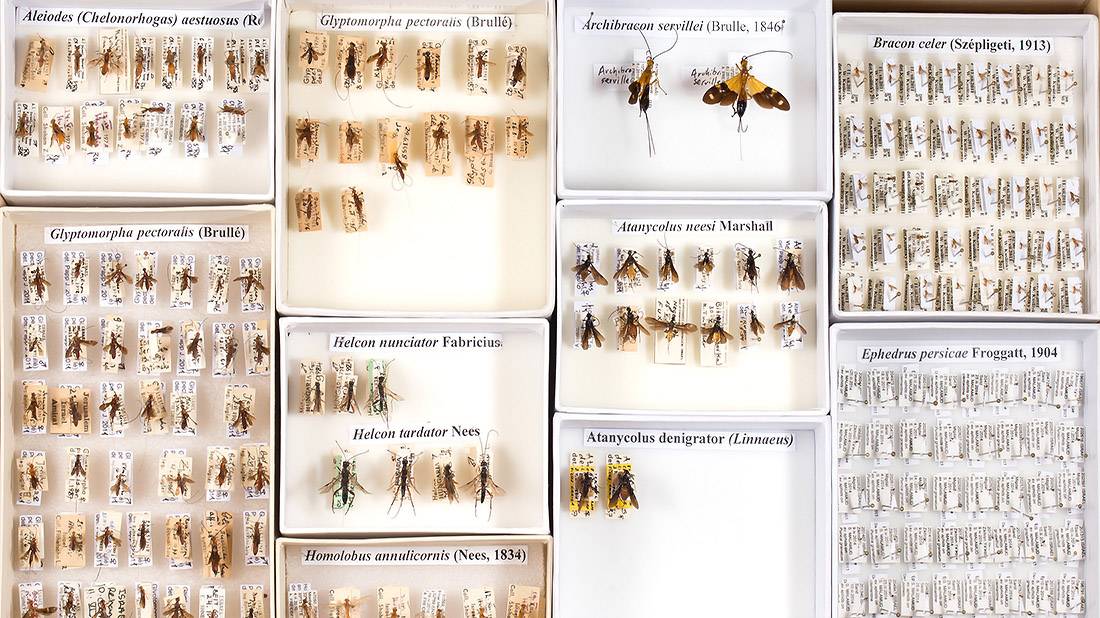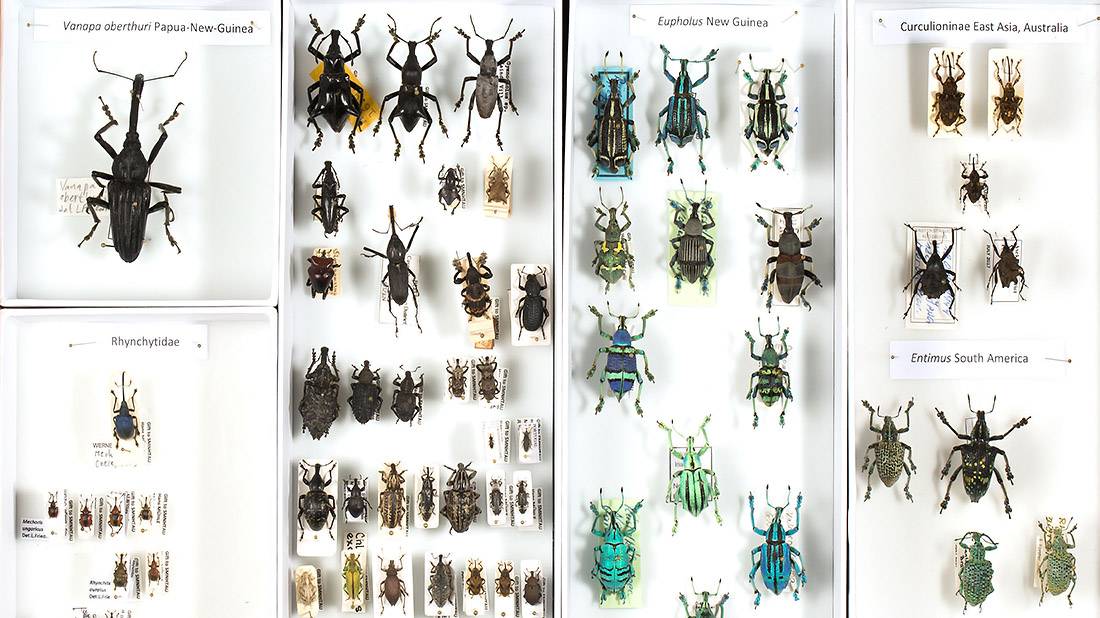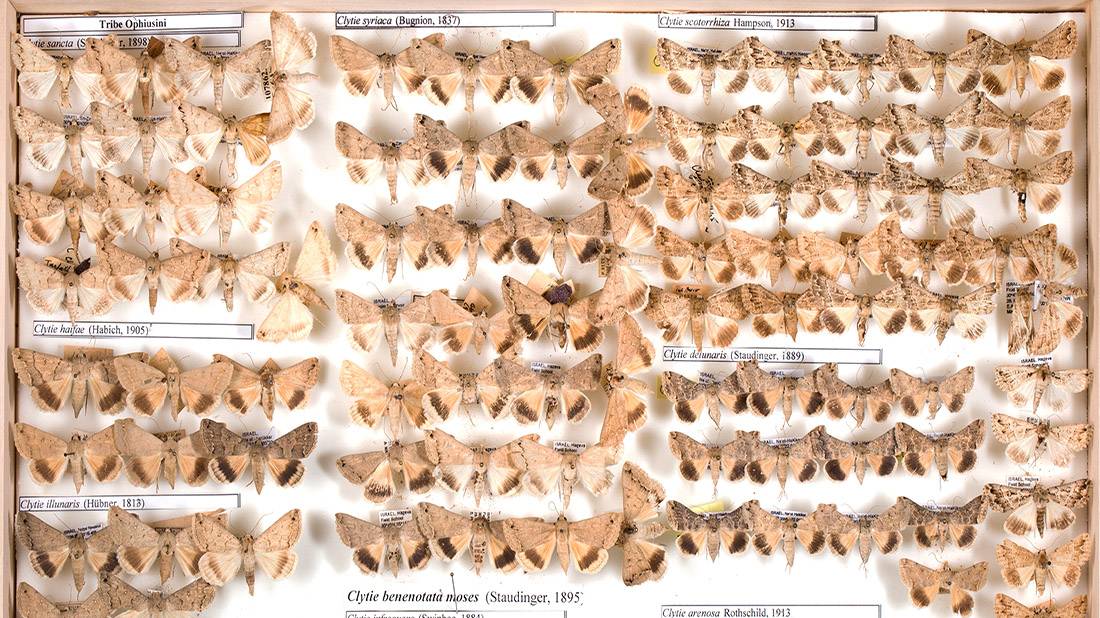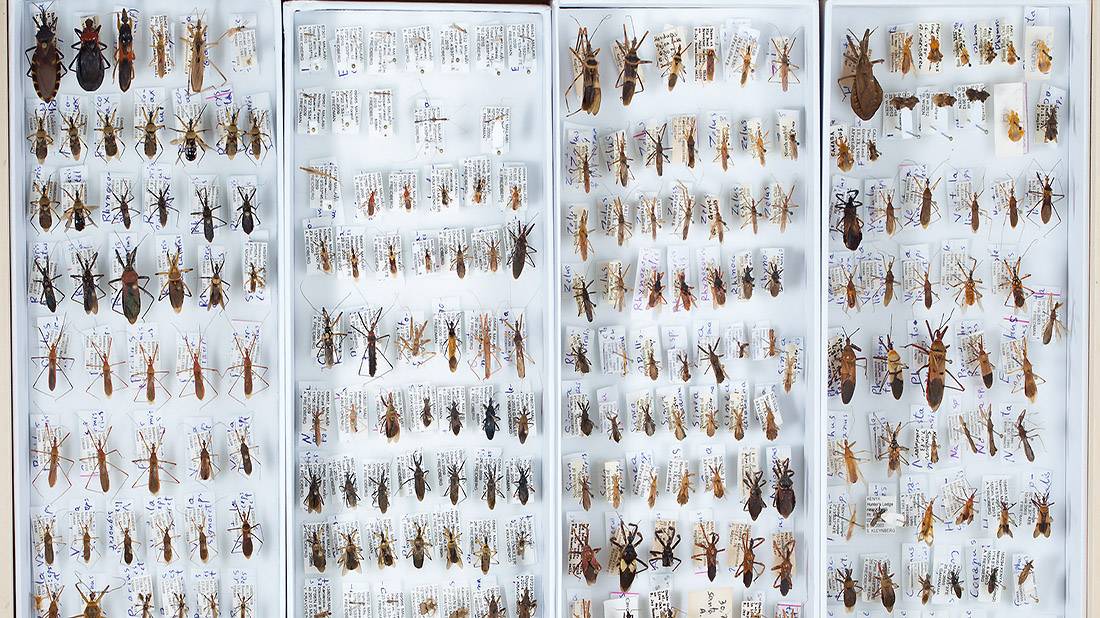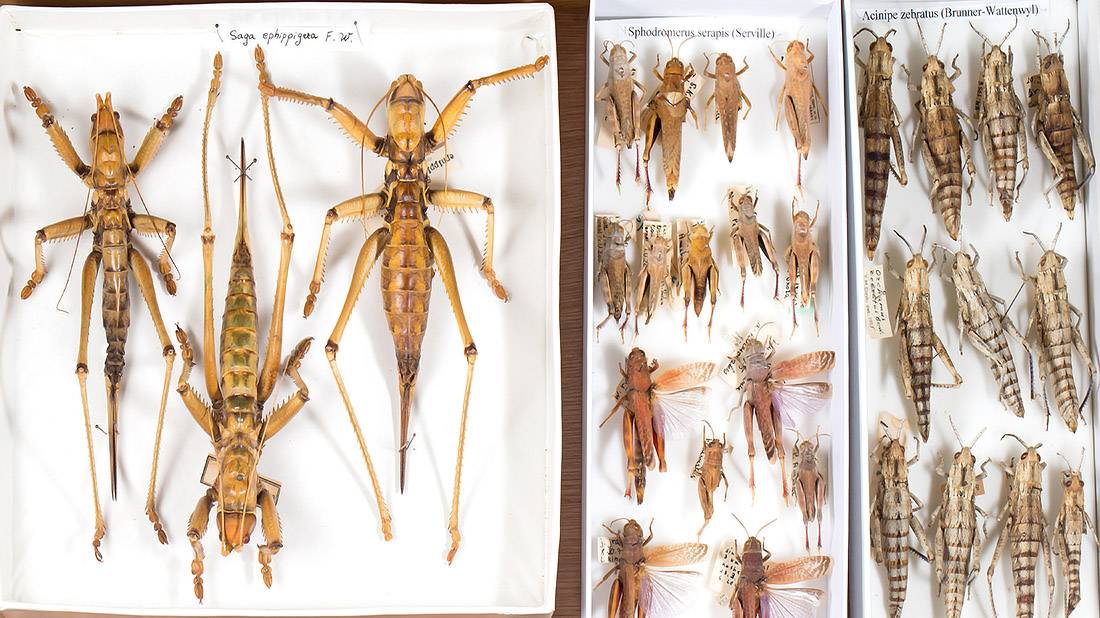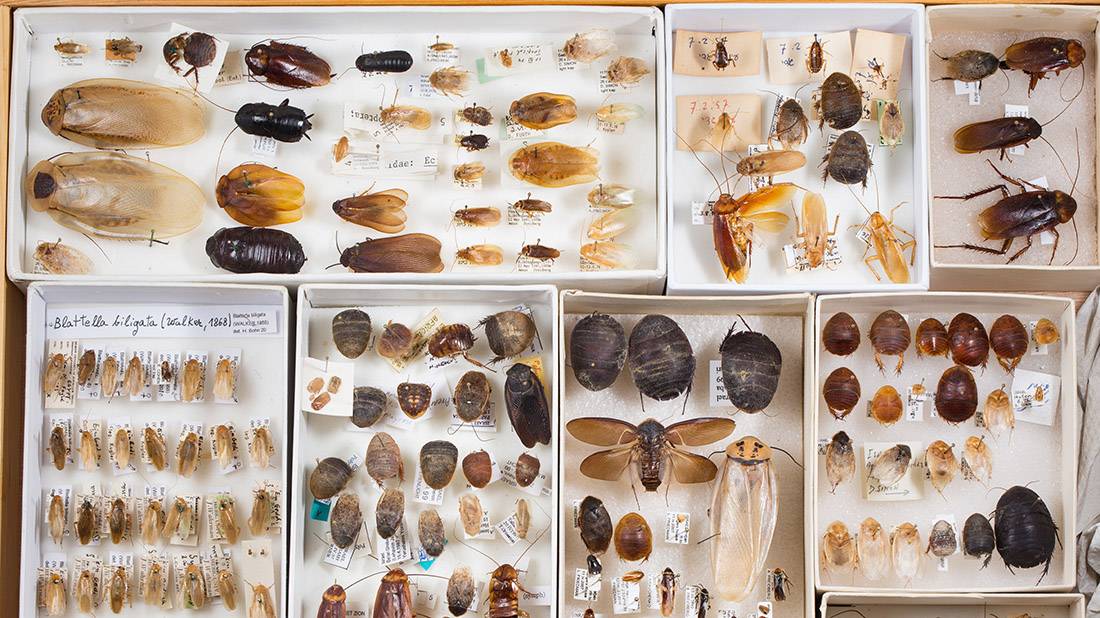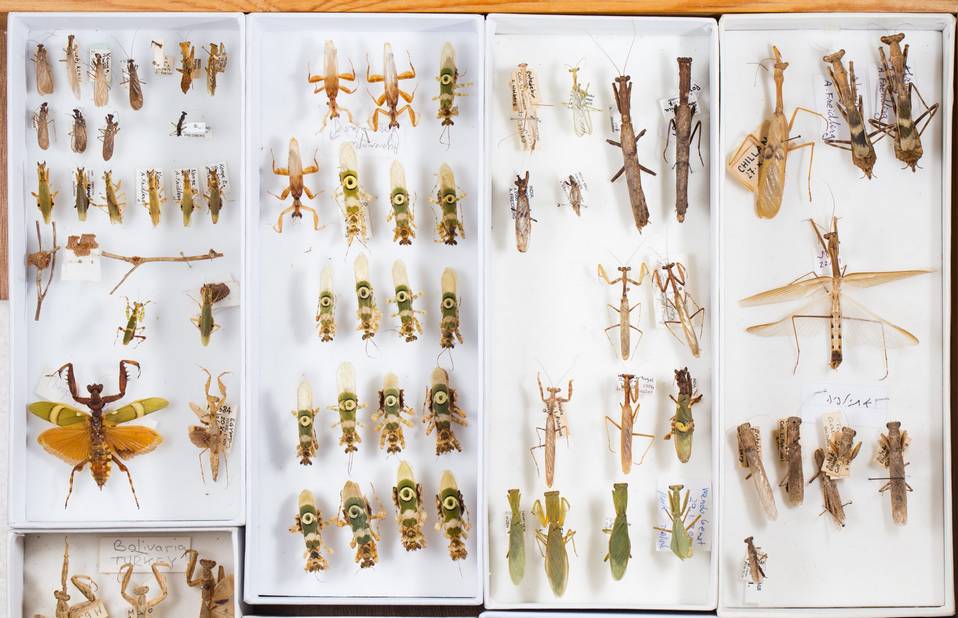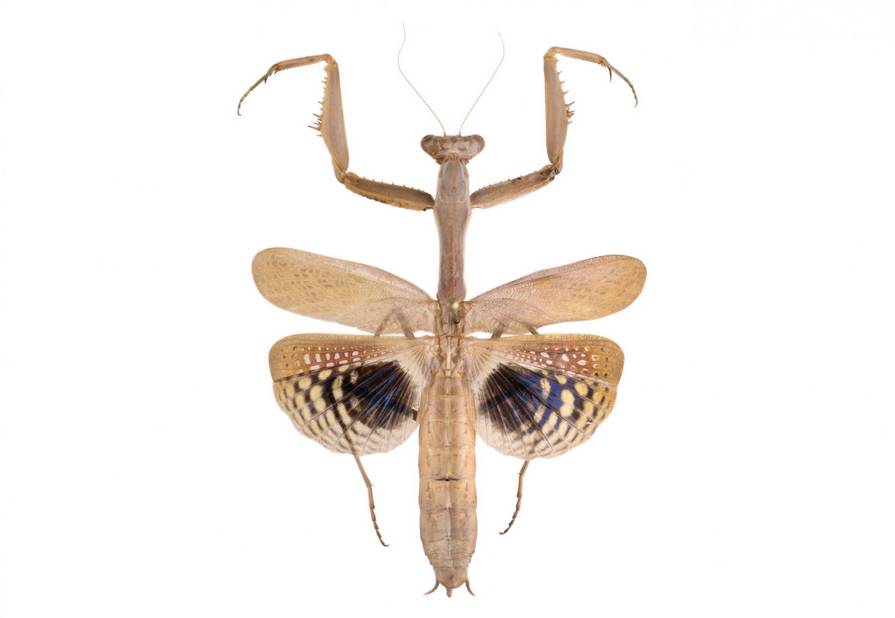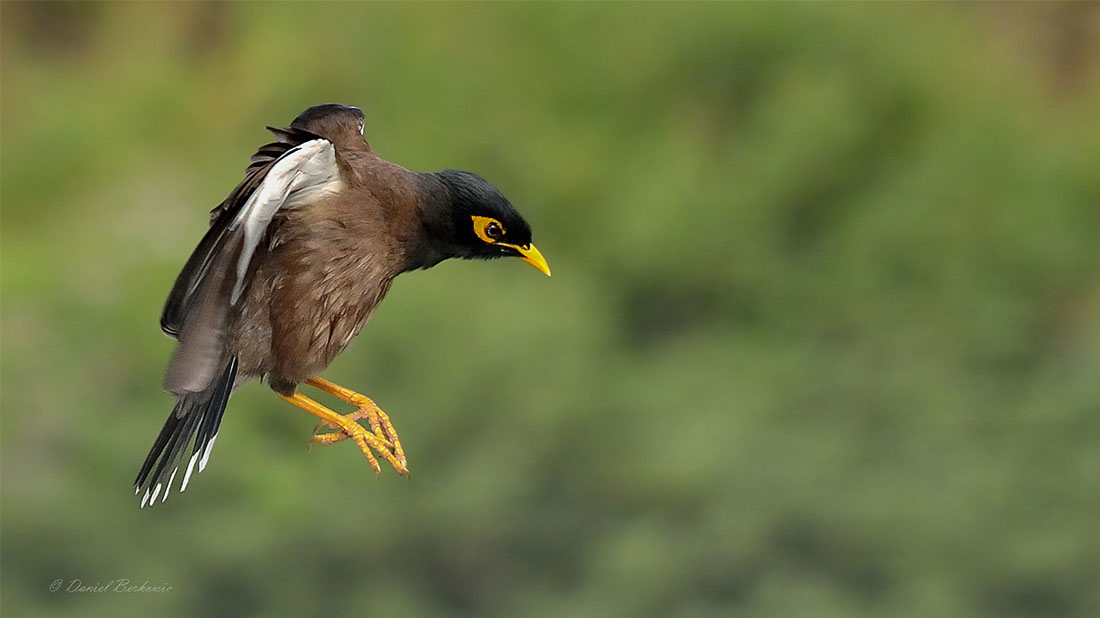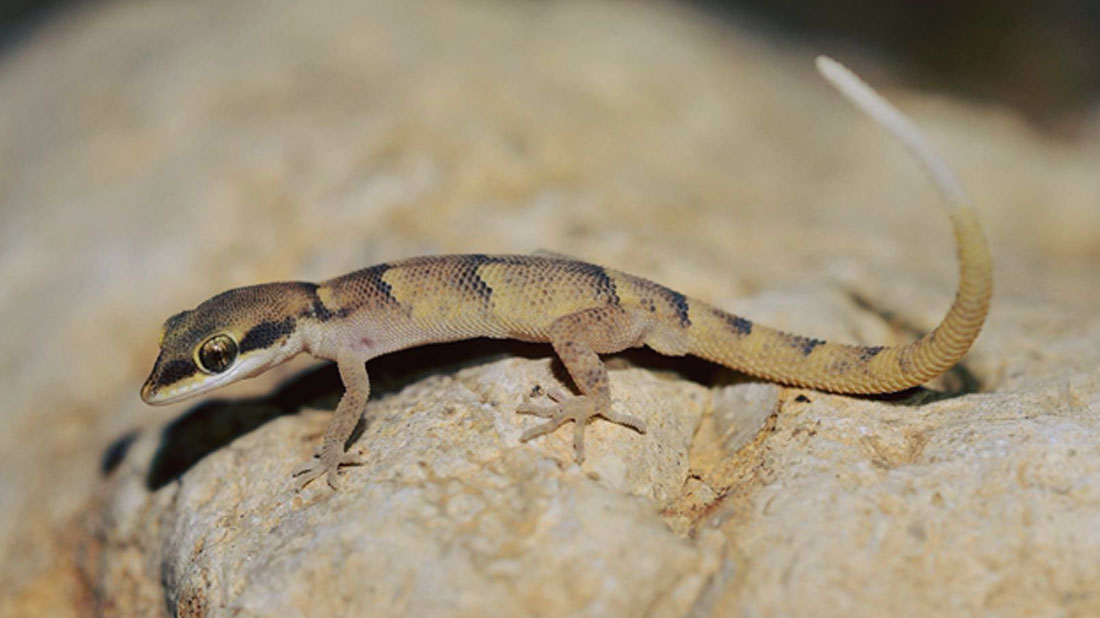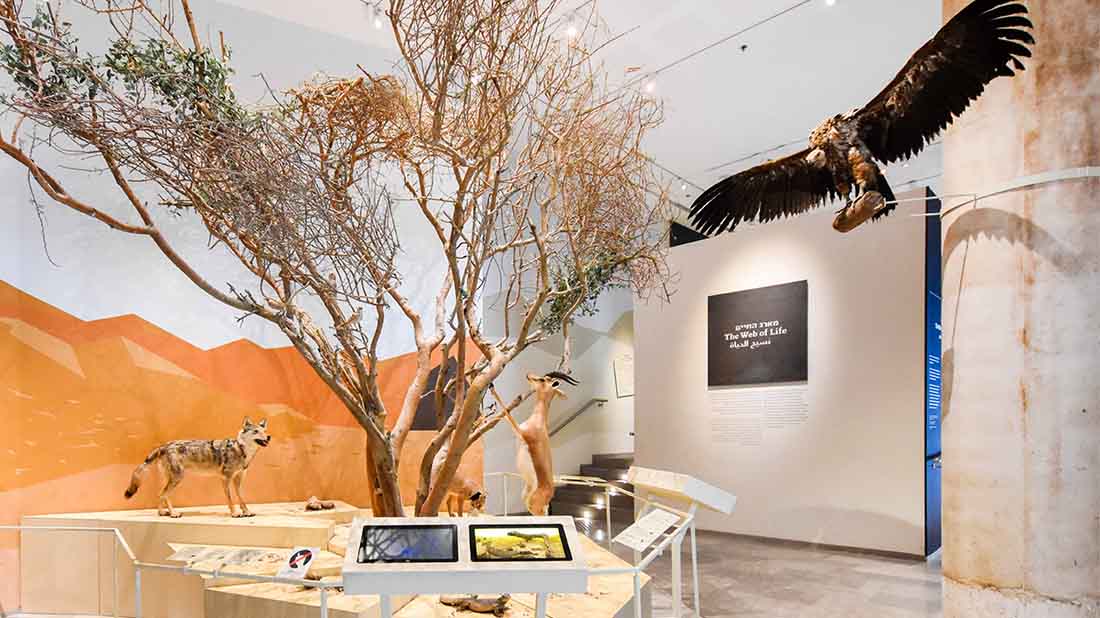The collection contains about 3 million pinned insects as well as numerous ethanol-preserved and slide-mounted specimens and various other insect-related specimens, such as galls and nests. The insect collection focuses mainly on the fauna of Israel and adjacent areas. However, it also contains vast collections from all parts of the world, particularly from tropical Africa. All 26 insect orders known from Israel are represented in this collection, which is by far the largest and best maintained of all such collections in Israel and the Middle East.
The insect collection at the Steinhardt Museum of Natural History was established around 1960 by the late Prof. Joshua Kugler, who served as its curator until 1980, when Dr. Amnon Freidberg replaced him. In 2012 Dr. Freidberg was succeeded by Dr. Netta Dorchin, who is the current chief curator of entomology at the museum. For about 15 years the collection had been kept on the Tel Aviv University campus in Abu-Kabir in southern Tel Aviv, before it was transferred in 1974 to the Ramat Aviv campus.
In recent decades a collection of live insects is also maintained by the entomology staff. As in other collections in the Steinhardt Museum, the insect collection focuses mainly on the fauna of Israel and adjacent areas. However, it also contains vast collections from all parts of the world, particularly from tropical Africa. All 26 insect orders known from Israel are represented in this collection, which is by far the largest and best maintained of all such collections in Israel and the Middle East. In addition, almost all families, genera and species known from the country, including approximately 1,000–2,000 undescribed species, are represented. The collection contains thousands of type specimens, including hundreds of primary types. Several insect species now considered extinct in Israel are also represented in the collection, some of which are probably unique to it. So far only a small portion of the collection has been databased and ongoing efforts are made to digitize all newly collected material as well as older material, but this is a slow process that will take many years to complete.
The pinned collection is housed on the second floor of the Steinhardt Museum, mostly in standardized drawers and cabinets, whereas the ‘wet collection’ is stored on the third floor. Large parts of the collection were donated or acquired over the years from the Hebrew University in Jerusalem and Rehovot and from various public and private holdings, and these have been or are in the process of being integrated into the general collection. The collection grows continuously, either through additions made by its staff during routine and special field trips and research projects in Israel and abroad, or through donations from organizations and individuals.
The entomology collection is maintained by 19 curators, associate curators and collection managers, almost all of whom hold graduate degrees (MSc or PhD) in entomology or zoology, and the staff includes also volunteers, post-doctoral fellows and graduate students. Each curator and collection manager is responsible for curating a particular group, and many of them conduct active research on these groups. The material is sorted to the most accurate level based on our in-house expertise and sent to external experts for further classification when needed and possible. Dozens of scientists from Israel and abroad visit the collection each year and use our material for their research.
Hundreds of publications have been based on the Steinhardt Museum insect collection and numerous articles are added by our staff, collaborators and visiting scientists every year. The main activities focus on collecting, preserving and studying the East Mediterranean fauna in order to record and understand the regional biodiversity. Other major activities include the provision of identification services to various organizations and individuals, in particular the Ministry of Agriculture and Rural Development of Israel, the Israel Nature and Parks Authority, and the Hama’arag, as well as support for graduate student research.
Diptera
The Diptera collection at the Steinhardt Museum is by far the largest of the entomological collections and consists of more than 500,000 labelled specimens. The absolute majority of these specimens are pinned insects in about 1600 drawers in 26 cabinets, and others are slide-mounted or ethanol-preserved samples. The collection includes representatives of 110 families (16 Nematocera, 23 Brachycera Orthorrhapha, 60 Acalyptratae, 11 Calyptratae) and holds almost 600 primary types and thousands of secondary type specimens.
The bulk of the material was collected by Jehoshua Kugler, Oskar Theodor and Amnon Freidberg, with substantial contributions by many other entomologists, including Fini Kaplan, Menachem Kaplan, Ilan Yarom, Yitzhak Nussbaum, Laibale Friedman and Wolf Kuslitzky to name just a few. The geographical scope of the collection focusses on Israel, with some 4,000 species recorded from the country, but numerous expeditions and field trips have brought in a lot of material from all zoogeographic regions, especially from the Afrotropics but also from Hawaii, Nepal, Papua New Guinea, Peru and the Philippines.
Representation in the collection and the level of taxonomic treatment of the major dipteran groups and families vary considerably. The nematoceran families (crane flies, midges, gnats, mosquitoes and the like) are generally undercollected and largely unidentified, with several exceptions. The Cecidomyiidae (gall midges) have been actively collected and studied by Netta Dorchin since the 1990s, and the collection, including 26 primary types and many secondary types, comprises dozens of species from Israel and elsewhere that are still undescribed. The Culicidae (mosquitoes) section includes an important reference collection of dozens of species from around the world procured by Oscar Theodor, who also built the core of the Bombyliidae (incl. Mythicomyiidae) and Asilidae holdings. Among the higher Diptera (Acalyptratae and Calyptratae), groups that are well represented include the Tephritidae, Chloropidae, Drosophilidae, Lauxaniidae, Sepsidae, Ulidiidae, Muscidae and Tachinidae. The Tephritidae (true fruit-flies) received the best attention by far in recent decades due to the work of A. Freidberg, who together with his students and technicians, has been adding 10,000–15,000 dipteran specimens annually to the collection, identified thousands and described hundreds of species. The Diptera collection is studied actively by many experts from all over the world; every year hundreds of dipteran specimens are sent on loans and form the basis for numerous scientific publications.
Hymenoptera
The Hymenoptera collection at the Steinhardt Museum contains about 300,000 labeled specimens, including sawflies, parasitoid and other wasps, bees and ants.
The sawfly (Symphita) collection contains about 2,000 specimens of 156 species in 58 genera, and a small collection of approximately 200 specimens mainly from East Africa and the Near East. Most of the collection has been identified by David R. Smith (Smithsonian National Museum of Natural History). Sawflies are distributed predominantly in temperate regions, and the Israeli fauna is extraordinarily large and diverse, including about 12 desert species.
The parasitoid wasp collection in the museum is the largest in the Middle East, with over 2700 identified species in more than 900 genera. It contains 16 primary types and includes material collected by past and present university and Steinhardt Museum personnel, in particular the late Jehoshua Kugler, Hanan Bytinski-Salz and Dan Gerling, and the currently active Wolf Kuslitzky, Zoya Yefremova, Amnon Freidberg, Leonid Friedman, Netta Dorchin and David Furth. It also includes the extensive Chalcidoidea collection of the late Prof. David Rosen from the Hebrew University (mainly Aphelinidae), the collection of the late Qabir Argaman (Plant Protection and Inspection Services, Bet Dagan), and the collection of Yael Argov (The Israel Cohen Institute for Biological Control, Bet Dagan). The parasitoid wasp collection comprises pinned, slide-mounted, and ethanol-stored material with about 20,000 specimens of Chalcidoidea, Proctotrupoidea and Cynipoidea, as well as about 28,000 pinned specimens belonging to the Ichneumonidae and Braconidae (20,000 and 8,000 respectively). The collection includes a large number of reared specimens with the pertinent host records, as well as many specimens collected by net sweeping, Malaise and light traps. Approximately 70% of the Ichneumonidae have been studied, sorted and identified by J. F. Aubert (France) in the 1980s, D. Kasparyan (Russia) in 2008, several other taxonomists, and by Wolf Kuslitzky (ongoing). Within the Braconidae, 35% of specimens were identified, mainly by J. Papp (Hungary) over the last four decades, and the subfamily Microgastrinae is being sorted and studied by Gideon Pisanty in collaboration with J. L. Fernandez-Triana (Canadian National Collection, Ottawa, Canada). Among other parasitoid taxa, the Eulophidae have been identified by Zoya Yefremova, Eupelmidae by G. Gibson, Eucharitidae by J. Heraty, Torymidae and Eurytomidae by M. Zerova, and Cynipidae by G. Melika.
The collection of other aculeate wasps is based mainly on material collected by Hanan Bytinski-Salz, between 1940–1970. In 1983, he donated his collection to the Department of Zoology at Tel Aviv University (TAU). The collection continued to grow with the addition of donations from scientists and amateur entomologists, as well as with material collected since the 1960s by the TAU staff entomologists, mainly Jehoshua Kugler, Amnon Freidberg and Leonid Friedman. The collection mostly comprises specimens from Israel, but there are also several thousand specimens from different parts of Africa and Asia. A large number of Central Asian wasps was contributed by Sergei Zonstein and Irina Zonstein when they moved to Israel. Currently, the collection includes over 45,000 pinned and labeled specimens representing more than 360 genera in 18 families, 2 families in the Chrysidoidea, 6 in the Vespoidea and 10 in the Apoidea. Among these are several hundred holotypes and paratypes representing dozens of the region’s endemics. The collection includes a number of highly interesting species, such as Cryptocheilus sanguinolentus, known from a single specimen. Being the largest holding of this kind in the Middle East, this collection is used intensively by both Israeli and foreign scientists.
The bee collection currently includes between 40,000 and 50,000 specimens, 1,365 named species, and numerous additional subspecies, of 66 genera in five of the six recognized bee families (the small family Sternotritidae endemic to Australia is not represented). The great majority of specimens are from the Western Palaearctic region, mainly from Israel, other Eastern Mediterranean countries and Europe. The collection includes 20 primary types, mostly from Israel. The oldest significant holdings are those of Hanan Bytinski-Salz and Yehuda Wahrman, with records dating back to the 1930’s, followed by collections made in the 1980s and 1990s by Jehoshua Kugler, Amnon Freidberg, Chris O’Toole, and Rani Kasher. In the last ten years intensive sampling in different parts of Israel by Achik Dorchin, Gidi Pisanty, and Yael Mandelik as well as by other museum staff has yielded a large number of specimens that are currently being incorporated into the collection. About half of the specimens in the collection have been identified to the species level by international and local specialists, some genera have been recently revised (e.g., Xylocopa, Megachile, Eucera, Andrena) and others are in need of revision (e.g., Osmiini, Anthidiini). Several thousands of specimens that have recently been added to the collection had been databased, whereas label data of older specimens are yet to be captured. A large collection of Israeli Andrena spp. is currently studied by G. Pisanty and is barcoded in collaboration with Sophie Cardinal (Canadian National Collection, Ottawa, Canada).
The ant collection includes about 40,000 pinned specimens and about the same number of individuals preserved in ethanol. It was developed and curated by the late Prof. Jehoshua Kugler. Among other notable collectors are Hanan Bytinski-Salz, Amnon Freidberg, Qabir Argaman, Meir Pener, David Furth, Merav Vonshak, Jean-Jacque Itzhak Martinez and Elizabeth Morgulis. Over the years, several private collections have been incorporated, such as those of Hanan Bytinski-Salz, Ya’akov Palmoni and Jacob Wahrman. The “Schmitz collection”, which was part of the Natural History Museum at St. Paulus-Hospice in Jerusalem, is now housed at the Steinhardt Museum and is of special historical and scientific value; this is the first scientific myrmecological collection from the region, containing material from Israel identified by A. Forel, including syntypes of six taxa. This material provided a basis for the first review of the local ant fauna by Ernst Schmitz (1911). At present, 871 taxa have been identified at least to the genus level, about 240 of which from Israel. The Israeli ant fauna currently comprises 49 species and subspecies that are endemic to Israel (25 spp.) or to Israel and neighboring countries; 157 taxa have a broader distribution, and 16 are tramp species but only one of them (Paratrechina longicornis) is presumably established in natural habitats in Israel. The collection includes 12 primary types.
Coleoptera (beetles)
The Coleoptera collection comprises approximately 400,000 pinned specimens and 10,000 ethanol-preserved adults and larvae. The main and most important part of the collection are beetles from Israel and the Sinai Peninsula, comprising about 200,000 specimens of ca. 6,000 species. The remaining are specimens from tropical Africa, Madagascar, Southeast Asia, North and Central America, Papua New Guinea and the Western Palaearctic Region. Most of the Palaearctic families (approx. 100) and a good number of the tropical families are represented. Among the best represented groups are weevils (Curculionoidea), ground beetles (Carabidae) and leaf beetles (Chrysomelidae). The Coleoptera collection includes 80 holotypes and numerous paratypes of several hundred species from Israel and elsewhere. The collection contains unique material from the beginning of the 20th century as well as species that have become extinct or extremely rare since, some of which from biotopes that no longer exist (e.g., Lake Hula).
The older part of the collection includes undated specimens (probably collected at the end of the 19th to the beginning of the 20th centuries), which were probably purchased by F.S. Bodenheimer or H. Bytinski-Salz from the famous coleopterist and insect trader E. Reitter, including European and Israeli specimens. Other old material includes beetles collected in Israel by E. Schmitz (1910s), I. Aharoni (1920s), F.S. Bodenheimer (1920s–1940s) and Y. Palmoni (1920s–1960s). The core of the material comprises the private collection of the late H. Bytinski-Salz (1930s–1970s), the collection of the late J. Halperin (Ilanot) (1940s–1990s), collections of entomologists from the Hebrew University (e.g., M.P. Pener, J. Wahrman, O. Theodor, S. Blondheim, A. Moscona, P. Amitai, R. Ortal), and material collected from the 1950s to date by members and students of the Department of Zoology, Tel Aviv University (e.g., J. Kugler, A. Freidberg, D. Furth, M. Kaplan, F. Kaplan, D. Gerling, L. Fishelson, Ch. Lewinsohn, A. Gasith, A. Shlagman, I. Yarom, V. Chikatunov, V. Kravchenko, G. Wizen, R. Hoffmann, A.L.L. Friedman) and by amateur coleopterists (e.g., E. Orbach, A. Traub, A. Yoffe).
Most collecting in early years was done by means of net sweeping and direct collection. In recent decades, an important addition to the collection has been made by V. Kravchenko (Steinhardt Museum), who employs light traps extensively, and by numerous students of T. Dayan and I. Renan (Steinhardt Museum), E. Groner (Ben-Gurion University) and U. Shanas (University of Haifa), who use mainly pitfall traps.
Lepidoptera
The Lepidoptera collection contains at least 100,000 pinned specimens, including many types, representing about 6,000 species of macro-Lepidoptera and about 3,000 species of micro-Lepidoptera from Israel, neighboring countries and other regions. As such, this is presently the best collection of Middle Eastern Lepidoptera among European and American holdings. Entomologists who contributed to the Lepidoptera collection include Y. Palmoni (Bet Gordon, Dganya) and P. Reich, and the oldest specimens—some of which date back to the end of the 19th century—are butterflies collected by E. Schmitz and P. Reich. Material of certain taxonomic groups has been sorted and identified by specialists, including Rhopalocera (D. Benyamini, O. Rittner), Pyralidae (Y. Palmoni), Noctuidae (V. Kravchenko, L. Ronkay, M. Fibiger, H. Hacker), Bombicoidea (G. Müller), Gelechiidae (A. Bidzilya), Oecophoridae (A. Lvovskiy, S. Sinev) and others. Many Israeli species are rare, very local or threatened, such as those confined to coastal sand dunes or to the sands of the Arava valley. Dozens of species described over the last decades are endemic to Israel, and their types are deposited in the collection. Material from other regions includes specimens from Ethiopia (collected by V. Kravchenko), Madagascar (L. Friedman, A. Freidberg), Mali (G. Müller, V. Kravchenko), the Democratic Republic of the Congo (V. Kravchenko), Guinea-Conakry (V. Kravchenko) and Laos (V. Kravchenko). The Rhopalocera (7 families) and Noctuoidea (2 families) are very well represented, whereas the Bombicoidea (about 28 families) and micro-Lepidoptera (more than 30 families) are under collected and prooly studied at present. The Rhopalocera (butterfly) collection is composed of many (mostly private) collections, which are currently in the process of identification for the first time and are being integrated slowly into the general collection, including databasing of identified specimens. With the continuous addition of donated material, the butterfly collection will probably double its size within the next few years. The Lepidoptera collection is frequently used in the study of pest species injurious to crops or to human and animal health.
Neuroptera
The collection includes about 140 species of 9 families. The Myrmeleontidae (antlions) is the largest family in Israel with approximately 80 species, represented in the collection by about 2,500 pinned specimens. Of these, 7 species of the Palparini are recorded, including the rare Stenares irroratus known only from the southern Arava valley. About 30 species were determined by H. Holzel, some of which described by him from Israel and the Sinai Peninsula. The collection includes 13 holotypes and paratypes. The Chrysopidae (green lacewings) collection contains about 20 species, and the Nemopteridae (spoon and thread-winged lacewings) about 10 species, including the type series of Dielocroce hebraea from Israel. The unique Lerta palmonii was described from Israel but is now considered a synonym. Other families represented in the collection are Ascalaphidae (owlflies); Mantispidae (mantisflies) with 4 spp., including the wasp-mimicking Nampista auriventris; Coniopterygidae (dusty lacewings); Hemerobiidae (brown lacewings); Berothidae; and one species of the Sisyridae (spongeflies), Sisyra trilobata, from the Sea of Galilee. The Warman and the Palmoni collections were integrated into this collection.
Hemiptera
The first comprehensive list of the Hemiptera fauna of Israel was provided in Bodenheimer’s Prodromus Faunae Palestinae (1937), which contained 33 families and 477 species. Following an expedition to the area in 1958, Linnavuori (1960) published an article on the Hemiptera of Israel, in which he mentioned 36 families and 697 species. Today, the collection of Israeli Hemiptera at the Steinhardt Museum includes material received from the Hebrew University of Jerusalem collected by F. S. Bodenheimer, P. Amitai and J. Wahrman, as well as material collected by our own staff, including numerous specimens from other regions (mainly Africa).
The Auchenorrhyncha collection contains more than 30,000 pinned specimens, representing 15 families and about 280 species, as well as some ethanol-preserved specimens. Some specimens are identified only to the family level and the majority of species are not determined.
The Sternorrhyncha collection includes material of four superfamilies:
(1) The Aleyrodoidea (whiteflies) are represented by 28 species in nine genera, preserved in gelatin vials together with plant parts. There are also microscope slides of immatures and ethanol-preserved adults. The collection was updated in recent years by D. Gerling (TAU), M. Guershon (Steinhardt Museum) and V. Seplyarsky (Plant Protection and Inspection Services, Ministry of Agriculture).
(2) The Aphidoidea (aphids) comprise two important holdings on microscope slides, including many primary types: D. Wool’s collection of gall-inducing aphids (TAU) and E. Swirsky’s collection of aphids. There is also a small collection of pinned aphids and ethanol-preserved specimens.
(3) The Coccoidea (scale insects) collection contains about 20 jars of ethanol-preserved specimens and three boxes of microscope slides. This collection has not been curated yet.
(4) The Psylloidea (psyllids, or jumping plant lice) are represented by approximately 2,000 pinned specimens and four jars of ethanol-preserved adults comprising 95 species of 35 genera in five families. This material was collected mainly by A. Freidberg, and has been recently updated and identified by M. Spodek and D. Burckhardt (Basel, Switzerland). There is also a small collection of exotics, mainly from African countries.
The Heteroptera (true bugs) collection includes Israeli material from natural and agricultural habitats, including several invasive species that have been introduced into the country on ornamentals or on agricultural products. The collection also contains species from other regions that have been collected by our staff or received from colleagues as exchange. Overall, the collection comprises approximately 40,000 specimens, representing about 4,700 species in 40 families, including seven primary types. Work on this collection is conducted in cooperation with the Israel Ministry of Agriculture, Plant Protection and Inspection Services (PPIS), Israel Ministry of Health, Israel Nature and Parks Authority, the Jewish National Fund (JNF-KKL), Israel National Center for Aquatic Ecology, pesticide companies, veterinary services and private individuals, for which we provide identifications. The Israeli part of the Heteroptera collection is currently under intensive examination and parts of it have already been studied and identified in collaboration with prominent specialists. This process includes additions and updates to the database and preparation of checklists and illustrated field-guides to the Israeli taxa.
Orthoptera
The Orthoptera collection is composed primarily of Tettigoionidea and Acridoidea specimens from the well maintained holdings of M. Pener and J. Wahrman (the Hebrew University, Jerusalem). Subsequent additions and determinations were made by L. Fishelson (Tel Aviv University), with a major contribution to the Grylloidea collection. The Orthoptera collection contains about 2,700 specimens of 60 species in 26 genera of Tettigonioidea, including unique specimens of rare and endemic species, particularly from Mount Hermon, the Judean Desert and the Negev, and primary types of species described from Israel. The Grylloidea are represented by approximately 700 specimens of 39 species in 21 genera of crickets, including unique specimens of two minute mole-cricket species from the Dead Sea area, the Negev and the Arava Valley, and two tiny species of Myrmecophilus ant crickets that are endemic to Israel. The Acridoidea collection includes hundreds of specimens in more than 120 drawers, but a lot of this material still requires sorting and identification. The Gryllacridoidea are represented by several specimens of the rare desert nocturnal Lezina, which inhabits burrows in sandy habitats.
Blattodea
The Blattoidea collection includes 19 species in 4 families. Most specimens were identified by Horst Bohn (Ludwig-Maximilians-Universitat, Munich). One species, Heterogamodes hebraica, is known only from Israel. Six species are known as domiciliary pests. The Termitoidea collection includes 10 species in 4 families, mostly as ethanol-preserved specimens. Six species were described from Israel, and the taxonomic status of another two has not been determined yet. Most species are represented by alates, workers and soldiers; some are represented by a few specimens only. An effort is being made to clarify the taxonomic status of the Israeli termite fauna, including molecular analysis and scanning electron microscope study. Two common species of the Kalotermitidae, Longicaputermes sinaicus and Kalotermes phoeniciae, were recently redescribed.
Mantodea
The mantid collection is currently reorganized and the taxonomy of the Israeli species is revised by D. Simon, B. Shalmon and A. Weinstein. The collection contains about 30 species and the taxonomic status of another four is being investigated. The entire collection is databased. It includes some very common and widespread species such as Sphodromantis viridis, Mantis religiosa, Miomantis paykullii, Empusa fasciata and several Ameles spp., as well as rare species such as Galinthias (Attalia) philbyi and two unidentified species from the Arava valley. The tiny Holaptilon pusillulum has been described from Israel and is known also from Jordan.
Aquatic orders
Ephemeroptera
The collection comprises hundreds of ethanol vials, microscope slides and pinned mayfly adults and nymphs, with a total of over 30,000 specimens. This material represents the Israeli fauna of eight extant and locally extinct families, 15 genera and 25 described species, including type material of 12 species. While the great majority of the collection is from Israel, it also includes several samples from neighboring countries, as well as representatives of some Palaearctic, Afrotropical, Oriental and Australian taxa. Currently, it is the only important active collection of mayflies in the Middle East. Specimens were mainly collected in the course of three historical projects, in the early 1970s (led by M. Samocha), early 1990s (R. Ortal and M. Sartori) and in recent years (Z. Yanai). In most cases, mayflies were collected along with ecological data, providing further insight into their distribution patterns and ecological requirements. Most of the mayfly material has been determined to species or genus level by Z. Yanai in collaboration with M. Sartori and J.L. Gattolliat (Lausanne, Switzerland), including the descriptions of four new species whose types are deposited in the collection. Several additional descriptions of new species from Israel are expected in the near future once ongoing morphological and genetic studies on the species-rich Baetidae are completed.
Odonata
The collection contains about 4,000 specimens of 82 species in 36 genera of Israeli dragonflies and damselflies, and several dozen undetermined tropical species. The material includes rare species of the Afrotropical origin, for which Israel is the northernmost edge of their distribution range, as well as unique specimens of Urothemis edwardsi hulae (described from Israel) and Rhyothemis semihialina syriaca, which became extinct following the drainage of Lake Hula in the 1950s. The local fauna represents both Palaearctic and Afrotropical elements from various types of aquatic habitats. While most material comprises pinned adults, a few nymphs are included, and an ongoing study is aimed at associating life stages within species. The collection formed the basis for a comprehensive study of the local fauna in the late 1980s and early 1990s by H. Dumont.
Plecoptera
The stoneflies are strongly associated with aquatic habitats of high water quality and low temperatures, and thus are restricted to the relatively humid extreme north of Israel. The collection contains about 50 pinned specimens and several ethanol-preserved lots of five species in four genera.
Trichoptera
The collection contains about 60 species of caddisflies represented by about 1,500 pinned specimens and thousands of ethanol-preserved specimens in 80 jars, including several primary types of species described from Israel. The collection became the basis for important studies on the systematics and taxonomy of the local fauna, conducted in the early 1970s by A. Gasith and early 1990s by L. Botosaneanu. A recent, ongoing collection-based study aims at associating information on adults with that on larvae, which are the most informative life stage for ecological studies and stream biomonitoring schemes.
Small orders
Apterigota
The collection contains unique slides of Protura from Israel and Africa from the collection of M. Broza (Haifa University, Oranim); Collembola on slides and in ethanol, in particular the collection of R. Ortal (Israel Nature and Parks Authority) determined by A. Palissa (Berlin); Diplura and Thysanura in ethanol, collected mainly by J. Wahrman, M. Pener and J.L. Werner (Hebrew University of Jerusalem).
Phasmatodea (stick insects)
The collection contains several dozen specimens of three Israeli species in two genera. Bacillus atticus is widely distributed in the Mediterranean, with no known males and probably reproducing parthenogenetically. Ramulus eitami was described from the southern desert part of Israel in 1994. Although stick insects represent a relatively small group, one or two additional species might still be discovered in Israel, currently overlooked because of their extraordinary camouflage abilities.
Dermaptera
The collection contains about 1,000 pinned specimens of earwigs belonging to nine species in five genera.
Embioptera
The collection contains about 200 specimens belonging to four species in three genera.
Psocoptera
The collection contains about a dozen ethanol-preserved species from Israel, mainly from the collection of J. Halperin.
Phthiraptera. The collection includes about 2,400 slides of lice originally from the collection of M. Costa (University of Haifa, Oranim).
Raphidioptera
Only two species of snake flies in the family Raphidiidae are known from Israel.
Dichrostigma adanana is recorded mainly from the northern parts of the country, whereas Ulrike syriaca is more common and is known from central and northern Israel. Both species were identified by Horst Aspöck.
Mecoptera
This order is not represented in Israel. However, the collection contains about 10 specimens of Bittacus from Africa and America, and approximately 50 specimens of Panorpa from Europe, Japan, Thailand and the USA.
Siphonaptera
The collection contains about 1,200 slides of fleas originally from the collection of M. Costa (University of Haifa, Oranim).
Arachnida
Scorpiones. The collection includes approximately 500 specimens representing all widespread species of the regional fauna. However, this collection has not been studied actively since the 1970s, hence the material needs to be sorted and identified. This is also true for the less substantial collection of Solifugae (sun spiders, camel spiders; 150 specimens).
Pseudoscorpiones. The collection includes about 300 specimens representing 15–20 species. The Israeli representatives have never been the object of a specific study, but this collection is obviously of high value for further research in this area. The same is true for the Opiliones (harvestmen), with less than 100 specimens in the collection.
Araneae. The Israeli fauna includes approximately 660 recognized species but the actual number is estimated at 900 or even more. The spider collection includes about 15,000 ethanol-stored specimens belonging to 750 species in 57 families (including ca. 600 species collected in Israel). The core of the collection is based on material collected by Y. Mandelik, T. Levanony, U. Columbus, O. Skutelsky, M. Vonshak, I. Bernstein and L. Friedman (among others) in 1998–2009. This material has been sorted, identified and updated in collaboration with G. Levy and E. Gavish-Regev (Hebrew University of Jerusalem), D. Logunov (Manchester University), Yu. Marusik (University of Turku) and some other researchers. As a result, the identified and taxonomically ordered spider collection in the museum was established in 2003–2004. Having been based mainly on the Israeli fauna, the collection includes substantial material from temperate and tropical Asia (Georgia, Azerbaijan, Kyrgyzstan, Uzbekistan, Tajikistan, Afghanistan, Laos, Thailand) and Africa (Democratic Republic of Congo, Ethiopia, Mali). It includes primary types of 24 species belonging to the following genera (number of species in brackets): Anemesia (9), Filistata (1), Levymanus (1), Microfilistata (2), Phyxioschema (1), Raveniola (3), Synaphris (1), Ummidia (1), Zaitunia (5), as well as hundreds of paratypes. The collection also contains at least several dozens of undescribed species from Israel and other countries/regions.
Staff members
Curators
Prof. Netta Dorchin, Section Leader – Chief curator of Entomology, Flies
Prof. Vladimir Chikatunov – Beetles
Dr. Sergei Zonstein – Spiders
Dr. Gal Ribak – Beetles
Prof. (emeritus) Abraham Hefetz – Bees (Curator emeritus)
Dr. Dany Simon – Mantids, roaches, lacewings (Curator emeritus)
Associate curators
Dr. Yael Mandelik – Bees (the Hebrew University)
Dr. David Furth – small orders (the United States National Museum of Natural History)
Dr. Inon Scharf – Lacewings
Collection managers
Dr. Zoya Yefremova – Parasitoid wasps
Dr. Gideon Pisanty – Parasitoid wasps
Dr. Moshe Guershon – Grasshoppers, katydids, crickets
Dr. Wolf Kuslitzky – Parasitoid wasps
Dr. Armin Ionescu-Hirsch – Wasps and ants
Dr. Tatyana (Tania) Novoselsky – Heteroptera
Ariel-Leib-Leonid (Laibale) Friedman – Beetles
Dr. Elizabeth (Liz) Morgulis – Flies
Dr. Mike Mostovski – Flies
Dr. Malkie Spodek – Aphids, whiteflies, scale insects, jumping lice, cicadas
Oz Rittner – Butterflies and moths
Ofir Tomer – Lepidoptera (moths and butterflies)
Volunteers
Dr. Avi Keysary
Tirza Stern
Dr. Binyamin Shalmon
Amir Weinstein
Ronit Vilker Alhadef
Nathan Sharon


